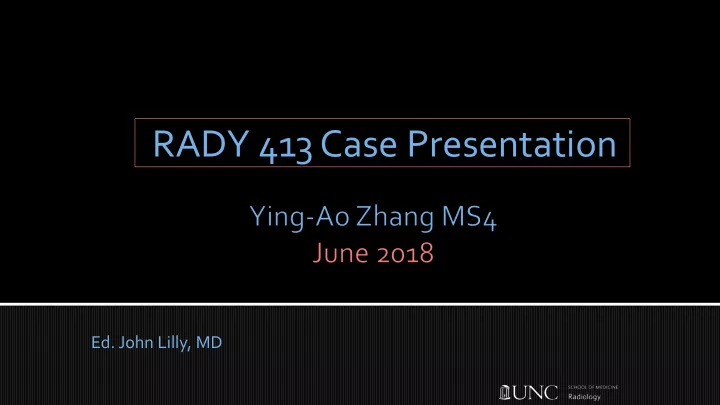

RADY 413 Case Presentation Ed. John Lilly, MD
30 year old lactating female presenting with worsening right breast swelling and erythema, with new hardened area
AD is a 30 y/o previously healthy G1P1001 F who presents with a 2- week history of worsening right breast pain and expanding erythema. She is currently 10 wks postpartum and exclusively pumping. Pt first noticed erythema two weeks ago and had been self-managing with warm compresses. 5 days ago, she received a prescription of dicloxacillin from her OB. Despite continued treatment, she reported a dramatic increase in size and erythema of the breast, in addition to new low grade fevers and chills.
Physical exam: ▪ Induration and erythema at 12- 1 o’clock position at the R breast ▪ 8cm tense and tender mass at same position
Focused R breast ultrasound 8
Longitudinal image Transverse image
Irregular 7.5 x 4.6 cm fluid collection with overlying skin thickening, consistent with an abscess BI-RADS 2: Benign Ultrasound-guided aspiration recommended
Ultrasound-guided aspiration of abscess
Following informed consent, utilizing sterile technique and local anesthesia with 1% lidocaine, under ultrasound guidance, a 18g needle was used to aspirate the abscess. 100 mL of turbid, light brown / serosanguinous, Needle intraprocedure milky fluid was withdrawn; the initial 10 cc aliquot was sent to Micro lab for gram stain and culture and sensitivity. Small to moderate sized residual collection was undrainable due to complicated nature of collection
Right breast post aspirate with wedge-shaped 100 cc infected thick milky fluid were aspirated erythema and skin induration with improved mass effect at 12/1:00 in breast
Preliminary cultures on initial 10cc aliquot of aspirate 3+ PMNs and 4+ Gram+ cocci Pt evaluated at Breast Surg clinic and was switched from PO dicloxacillin to PO clindamycin 300mg q6h ▪ Surg breast clinic will continue to follow closely
Lactational mastitis 1,3,5 ▪ Estimated 2-10% of breastfeeding women ▪ Typically as a result of either poor drainage or prolonged engorgement ▪ Risk factors include blocked ducts, cracked nipples, antifungal creams, and breast pump usage ▪ Clinical presentation ▪ Breast swelling, tenderness, erythema ▪ Fevers >38.3C ▪ Myalgias, chills, malaise
Lactational mastitis 1,3,5 ▪ Microbiology ▪ Most likely MSSA and MRSA ▪ Less commonly s. pyogenes, e. coli, bacteroides spp., corynebacterium spp. ▪ Treatment ▪ Symptomatic treatment include NSAIDs, cold compressions, and continuation of milk expression ▪ Empiric abx include dicloxacillin or cephalexin 500mg q6h (clindamycin 300-450mg q8h w/beta-lactam hypersensitivity) ▪ If risk of MRSA, use TMP/SMX double strength BID or clindamycin 300mg q8h ▪ May progress to abscess formation if infection not treated promptly
Puerperal breast abscess 2,5 ▪ 14% of all breast abscesses ▪ Formation usually 5-28 days after onset of symptoms of mastitis ▪ DDx: ▪ Plugged duct - absence of systemic symptoms ▪ Galactocele - nontender, simple/complex milk cyst/mass on US ▪ Inflammatory Breast Cancer - consider if infection does not resolve + clinical correlation ▪ Treatment includes aspiration vs surgical I&D ▪ Aspirations may need to be repeated every 2-3 days until no collection remains
34 yo woman with history of nipple inversion with new focal breast tenderness and erythema Abscess was drained under ultrasound guidance. Stain and culture showed mixed flora, including corynebacterium spp.
Young female patient, currently lactating presenting with a palpable breast mass. Compression magnification mammogram demonstrates Targeted US demonstrates an oval mass that fat-fluid levels contains fat and fluid in palpable mass BI-RADS 2: Benign; aspiration not indicated
Peau d’orange on visual inspection; PET positive for left breast skin involvement and underlying FDG tracer-avid infiltrating tumor. Triple negative by IHC. Pt underwent neoadjuvant chemotherapy followed by L mastectomy.
Dixon, J. M., Chagpar, A. B., Sexton, D. J., Baron, E. L., Eckler, K. (2018). Lactational mastitis. 1. UpToDate. Last updated June 12 th , 2018. Dixon, J. M., Chagpar, A. B., Sexton, D. J., Baron, E. L., Chen, W. (2018). Primary breast abscess. 2. UpToDate. Last updated May 9 th , 2018. Kvist, L. J., Larsson, B. W., Hall-Lord, M. L., Steen, A., & Schalén, C. (2008). The role of bacteria in 3. lactational mastitis and some considerations of the use of antibiotic treatment. International breastfeeding journal , 3 (1), 6. Dixon, J. M., & Khan, L. R. (2011). Treatment of breast infection. BMJ , 342 (11), d396. 4. Dener, C., & İnan , A. (2003). Breast abscesses in lactating women. World journal of surgery , 27 (2), 5. 130-133. Amir, L. H., Forster, D., McLachlan, H., & Lumley, J. (2004). Incidence of breast abscess in 6. lactating women: report from an Australian cohort. BJOG: An International Journal of Obstetrics & Gynaecology , 111 (12), 1378-1381. Jahanfar, S., Ng, C. J., & Teng, C. L. (2013). Antibiotics for mastitis in breastfeeding women. The 7. Cochrane Library . Acsearch.acr.org. (2018). Appropriateness Criteria . [online] Available at: 8. https://acsearch.acr.org/list [Accessed 24 Jun. 2018].
Recommend
More recommend